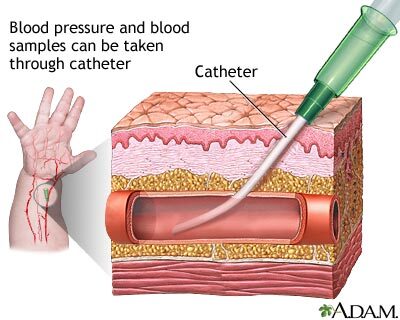Peripheral arterial line - infants
Alternative Names
PAL - infants; Art line - infants; Arterial line - neonatal
Information
A peripheral arterial line (PAL) is a tiny, short, flexible catheter that is put through the skin into an artery of the arm or leg. Health care providers sometimes call it an "art line" or "a pal." This article addresses PALs in babies.
WHY IS A PAL USED?
Providers use a PAL to watch your baby's blood pressure. A PAL can also be used to take frequent blood samples, rather than having to draw blood from a baby repeatedly. A PAL is often needed if a baby has:
- Severe lung and/or heart disease and is on a ventilator and/or other life support (for example, ECMO)
- Low blood pressure requiring medicine
- Prolonged illness or immaturity requiring frequent blood tests
HOW IS A PAL PLACED?
First, the provider cleans the baby's skin with a germ-killing medicine (antiseptic). Then the small catheter is put into the artery. The PAL is then connected to an IV fluid bag and blood pressure monitor.
WHAT ARE THE RISKS OF A PAL?
Risks include:
- The greatest risk is that the PAL can stop blood from going to the hand or foot. Testing before the PAL is placed can prevent this complication in most cases. The NICU nurses will carefully watch your baby for this problem.
- PALs have a greater risk for bleeding than standard IVs.
- There is a small risk for infection, but it is lower than the risk from a standard IV.
Gallery

References
Centers for Disease Control and Prevention website. 2017 Recommendations on use of chlorhexidine-impregnated dressings for prevention of intravascular catheter-related infections: an update to the 2011 guidelines for the prevention of intravascular catheter-related infections from the Centers for Disease Control and Prevention. www.cdc.gov/infectioncontrol/pdf/guidelines/c-i-dressings-H.pdf. Updated July 17, 2017. Accessed January 25, 2022.
Edwards LR, Malone MP, Prodhan P, Schexnayder SM. Pediatric vascular access and centeses. In: Zimmerman JJ, Clark RSB, Fuhrman BP, et al, eds. Fuhrman and Zimmerman's Pediatric Critical Care. 6th ed. Philadelphia, PA: Elsevier; 2022:chap 14.
Santillanes G, Claudius I. Pediatric vascular access and blood sampling techniques. In: Roberts JR, Custalow CB, Thomsen TW, eds. Roberts and Hedges' Clinical Procedures in Emergency Medicine and Acute Care. 7th ed. Philadelphia, PA: Elsevier; 2019:chap 19.
Stork EK. Therapy for cardiorespiratory failure in the neonate. In: Martin RJ, Fanaroff AA, Walsh MC, eds. Fanaroff and Martin's Neonatal-Perinatal Medicine: Diseases of the Fetus and Infant. 11th ed. Philadelphia, PA: Elsevier; 2020:chap 70.
